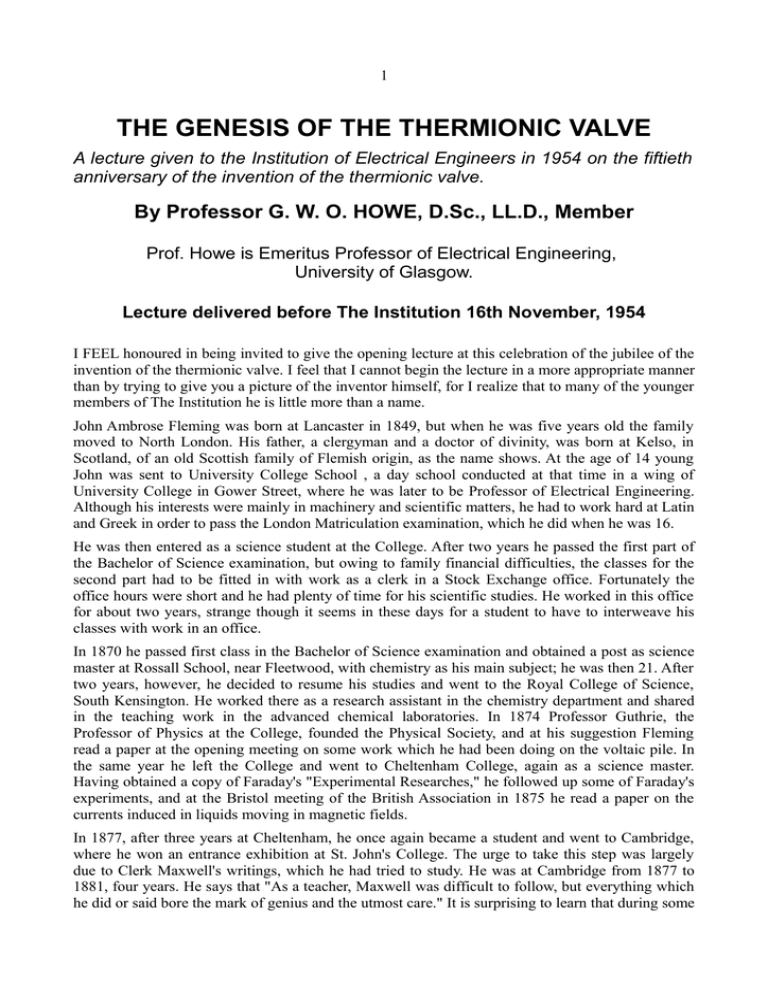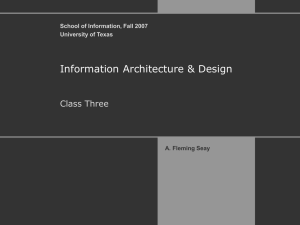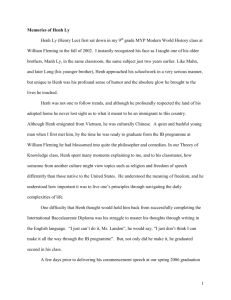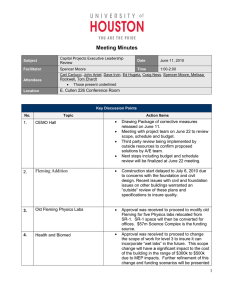THE GENESIS OF THE THERMIONIC VALVE
advertisement

1 THE GENESIS OF THE THERMIONIC VALVE A lecture given to the Institution of Electrical Engineers in 1954 on the fiftieth anniversary of the invention of the thermionic valve. By Professor G. W. O. HOWE, D.Sc., LL.D., Member Prof. Howe is Emeritus Professor of Electrical Engineering, University of Glasgow. Lecture delivered before The Institution 16th November, 1954 I FEEL honoured in being invited to give the opening lecture at this celebration of the jubilee of the invention of the thermionic valve. I feel that I cannot begin the lecture in a more appropriate manner than by trying to give you a picture of the inventor himself, for I realize that to many of the younger members of The Institution he is little more than a name. John Ambrose Fleming was born at Lancaster in 1849, but when he was five years old the family moved to North London. His father, a clergyman and a doctor of divinity, was born at Kelso, in Scotland, of an old Scottish family of Flemish origin, as the name shows. At the age of 14 young John was sent to University College School , a day school conducted at that time in a wing of University College in Gower Street, where he was later to be Professor of Electrical Engineering. Although his interests were mainly in machinery and scientific matters, he had to work hard at Latin and Greek in order to pass the London Matriculation examination, which he did when he was 16. He was then entered as a science student at the College. After two years he passed the first part of the Bachelor of Science examination, but owing to family financial difficulties, the classes for the second part had to be fitted in with work as a clerk in a Stock Exchange office. Fortunately the office hours were short and he had plenty of time for his scientific studies. He worked in this office for about two years, strange though it seems in these days for a student to have to interweave his classes with work in an office. In 1870 he passed first class in the Bachelor of Science examination and obtained a post as science master at Rossall School, near Fleetwood, with chemistry as his main subject; he was then 21. After two years, however, he decided to resume his studies and went to the Royal College of Science, South Kensington. He worked there as a research assistant in the chemistry department and shared in the teaching work in the advanced chemical laboratories. In 1874 Professor Guthrie, the Professor of Physics at the College, founded the Physical Society, and at his suggestion Fleming read a paper at the opening meeting on some work which he had been doing on the voltaic pile. In the same year he left the College and went to Cheltenham College, again as a science master. Having obtained a copy of Faraday's "Experimental Researches," he followed up some of Faraday's experiments, and at the Bristol meeting of the British Association in 1875 he read a paper on the currents induced in liquids moving in magnetic fields. In 1877, after three years at Cheltenham, he once again became a student and went to Cambridge, where he won an entrance exhibition at St. John's College. The urge to take this step was largely due to Clerk Maxwell's writings, which he had tried to study. He was at Cambridge from 1877 to 1881, four years. He says that "As a teacher, Maxwell was difficult to follow, but everything which he did or said bore the mark of genius and the utmost care." It is surprising to learn that during some 2 terms in 1877, 1878 and 1879 Maxwell had as his only audience Fleming and a Mr. Middleton. "On one or two occasions," Flemingsays, "I remember Maxwell gave a university lecture to me as his only audience." Although perhaps hardly relevant to to-day's proceedings, there is a point to which I should like to refer, because it has always somewhat mystified me. Although he sat at the feet of Clerk Maxwell for two or three years, in his "Elementary Manual of Radio-Telegraphy," published in 1908, Fleming says that, in the electromagnetic waves radiated from an aerial, if the electric and magnetic fields are plotted, a wavy line is obtained in each case, "but the maximum of one curve coincides with the zero point of the other." He advises the reader to make a model with two pieces of cardboard placed at right-angles and on each card draw a wavy line, but so that the maximum point of one lies over the zero point of the other. "One of these lines," he says, "should be marked E and the other H." All this was corrected and the wavy lines brought into phase when the second edition of the book was published. But the seed had been sown, and in P. P. Eckersley's book, "All About Your Wireless Set," we read "Flip! the electric strain goes past; flip! the magnetic strain goes past." He refers the reader to Fleming's graphical illustration. More surprising, in Volume 1 of Stanley's "Textbook of Wireless Telegraphy," published in 1919, he pictures the radiated fields being of different colours and refers to a red colour of electric strain giving place to a yellow colour of magnetic strain, and so on. It must be remembered that Fleming wrote his book 30 years after he had heard Maxwell's lectures, and that during most of this time electromagnetic waves formed no part of his mental activities. While at Cambridge in 1879, Fleming was awarded the Doctorate of Science of London University, and the following year he obtained the Cambridge Bachelor of Arts degree, with a first class in the Natural Science Tripos. He then stayed on for a year as a demonstrator in mechanism. In 1881 he was appointed Professor of Physics and Mathematics at the new University College of Nottingham, but he had only been there a few months when he obtained an appointment in London, which he said he was "only too glad to accept." In 1879, while still at Cambridge, he had been appointed scientific adviser to the Edison Telephone Company, which was involved in litigation with the Government; now, three years later, in 1882, he was appointed "electrician" to the Edison Electric Light Company, of which John Hopkinson was the scientific adviser. In those days the word "electrician" had quite a different meaning from what it has to-day. In 1884 he went to America to discuss with Edison the difficulties of the electric lighting industry in England, which were largely due to restrictive legislation. This close link between Fleming and Edison is of importance in connection with the thermionic valve. Since the British Association meeting that year was in Montreal, he took the opportunity of going to the meeting, and he visited many of the cities of Eastern Canada. He then returned to New York and made a thorough investigation of the electric light industry in America, which he embodied in a report to his directors on his return to this country. Five years before this, in 1879, Edison had obtained a British patent for a carbon-filament lamp of high resistance. In 1884, the year of Fleming's visit to him, Edison exhibited at Philadelphia an interesting discovery which he had made the previous year: he had fixed in the bulb of a carbonfilament lamp a metal plate carried by a platinum wire sealed through the wall of the bulb, and found that if the metal plate was connected through a galvanometer to the positive terminal of the filament the galvanometer showed that current was flowing; but if the connection was made to the negative terminal, no current was indicated. This phenomenon was subsequently known as the Edison effect. Edison made practical use of the device, but not for telegraphy. He connected the lamp filament with a suitable adjusting resistance across the mains in the power station. When the voltage between the mains had the correct value the filament had a certain temperature and the current flowing 3 through the galvanometer was indicated by its pointer. If the voltage between the mains increased above the normal value, the brightness of the filament, and with it the current through the galvanometer, increased. Conversely, if the mains voltage fell below the normal, the galvanometer current decreased. The pointer of the galvanometer was made to operate as a relay and rectify any variation of voltage from the normal value. The Edison effect greatly interested Fleming, and he got the Edison Swan lamp works to make him a number of lamps with the metal plate of different sizes and shapes and in different positions with respect to the carbon filament. From his experiments he came to the natural but erroneous conclusion that atoms of carbon carrying a charge of negative electricity were responsible for the current through the vacuum, but later he found that the hot cathode could be made of platinum, instead of carbon which Edison had always used. It was not until 1889 that J. J. Thomson showed that the effect was due to the emission of electrons. Fleming also says: "The second discovery I made was that negative electricity from any battery could pass from the hot filament to the cold metal plate, but not in the opposite direction. The space between the filament and the metal plate is a one-way street for electricity." He says that he described all these experiments in a lecture to the Royal Institution in 1890, and more fully to the Physical Society in 1896. Note these dates, 1890 and 1896; hence, many years before he took out his patent he had described this rectification. In 1885, the year following his American visit, he was appointed to the newly-created Professorship of Electrical Engineering at University College in Gower Street. He says that the equipment of the department consisted of a blackboard and a piece of chalk. His first association with wireless telegraphy was in 1899, when he was appointed scientific adviser to the Marconi Company. He had much to do with the design and equipment of the station at Poldhu from which the first transatlantic signal was transmitted in December, 1901. It was in October, 1904, twenty years after his visit to Edison, that it suddenly occurred to him that the Edison effect could be used to rectify alternating currents of high frequency. The next day he ordered a dozen lamps with metal cylinders round the filament from the Edison Swan factory, and on 16th November he applied for a patent, which, in accordance with the terms of his agreement with the Marconi Company, became their property. This was a bitter pill, for, in his own words, "As the original inventor of the thermionic valve I have never received a single penny of reward for it, other than the retainer paid to me for years by the Marconi Wireless Telegraph Company. . . . One firm has sold valves for years made exactly in accordance with my patent specification, which they advertised and sold as "Marconi valves" although the Marchese Marconi had nothing whatever to do with the invention." This patent, which is the basic reason for our gathering here to-day, referred only to the diode rectifier. Up to this point I have confined myself to Fleming's upbringing, training and activities to that day in 1904 when, at the age of 55, he patented the thermionic valve. There were other activities to which I have not referred. Although I knew him only as rather an elderly man, I like to picture him in his younger days paying frequent visits to Switzerland, climbing Mont Blanc in 1885, and in 1887 both Monte Rosa and the Wetterhorn. About the same time as Fleming's visit to Edison and his introduction to the Edison effect, much research was being carried out by Elster and Geitel in Germany on a phenomenon which had been known for many years, namely that when a metal is heated to incandescence the air in its neighbourhood becomes a conductor. They found that a metal plate in the neighbourhood of an incandescent filament acquired a negative charge, and that the effect is increased if the filament and plate are in an evacuated enclosure. In 1884 Hittorf, in Germany, noticed that if the cathode of a 4 vacuum tube was heated to incandescence a small e.m.f. passed considerable current. So far as I know, however, no practical application of these findings was suggested. In 1904, the year in which Fleming took out his patent, Wehnelt noted that if a filament was coated with certain oxides, such as those of barium or calcium, the emission of electrons was greatly facilitated; hence equal emission could be obtained with a lower temperature with greater sensitiveness and convenience of operation. The invention of the triode by Lee de Forest in 1906 was something for which Fleming never forgave him. It led to very much bitterness and almost endless litigation. Fleming had tried replacing the metal plate in the diode by a zigzag, platinum wire to see whether or not it was as effective as the plate in catching the electrons. It is amusing to read in his autobiography: "Sad to say, it did not occur to me to place the metal plate and the zigzag wire in the same bulb and use an electron charge, positive or negative, on the wire to control the electron current to the plate." Lee de Forest, who had been following my work very closely, appreciated the advantage to be so ' gained, and made a valve in which a metal plate was fixed near a carbon filament in an exhausted bulb and placed a zigzag wire, called a grid, between the plate and the filament. He thus put into one bulb the metal electrodes I had put into two separate bulbs and so made the first rudimentary form of the so-called three-electrode valve. This I consider rather unfair. Fleming had taken a well-known device, the Edison effect, and simply applied it in a new way, namely as a rectifier of high-frequency currents, whereas de Forest had introduced modifications of various kinds, but all directed to the variation of the direct current passing through the valve from a battery, by means of a third electrode, either outside or inside the valve. In the subsequent patent actions the American courts held that de Forest's addition of the grid, although a contribution of value, was not independent of Fleming's invention, even if, as de Forest maintained, he was unaware of it at the time. In his "Elementary Manual of Radio-Telegraphy," in 1908, Fleming says: A very simple but effective form of oscillator valve was invented by the author in 1904, based upon researches made many years previously, namely in 1890, upon the Edison effect in incandescent electric lamps." Then, without any mention of the third electrode, he says: This glow-lamp detector has been much used by Lee de Forest, disguised under the name of an Audion, and claimed as his own invention. It was, however, described in scientific papers and in patent specifications by the author long previously." This almost incredible distortion of the facts indicates the extreme bitterness of Fleming's feelings towards de Forest. The Fleming valve was purely and simply a rectifier or detector; it was in no way an intensifying device. While Fleming must be credited with being the first to apply thermionic phenomena to wireless detection, the intensifying properties of the present-day valve are far more important than its rectifying properties. When the Fleming patent expired in 1918, the Marconi Company applied for an extension, mainly on the ground that because of the 1914-18 War they had been unable to develop and make full use of the patent. The application was opposed by a number of firms and Government departments. The case was fought out in the law courts before Mr. Justice Sargant in December, 1918, and he dismissed the petition, as he found no sufficient reason for an extension of the patent. I was present in this case as an expert witness against the petition, and, of course, took part in some of the preliminary discussions, at some of which de Forest was present, together with his American lawyer. I thus have the advantage of having known personally Marconi and Fleming, and also de 5 Forest, who is still alive and quite active in California. In connection with this patent action I naturally had to go very thoroughly into the claims of Fleming and de Forest, but, as it is now 36 years since the action, my memory of the details is naturally rather vague. An interesting question is the extent to which Fleming's invention was adopted in the wireless industry. In a paper which I read at the British Association meeting at Portsmouth in 1911, on "Recent Developments in Radiotelegraphy," I said: "The filings coherer has practically disappeared. The magnetic detector used by the Marconi Company is ideal in its simplicity and reliability, but is not so sensitive as the electrolytic or mineral contact detector. The Telefunken Company have recently given up the electrolytic detector in favour of a detector of the latter type. Another type of detector used to a certain extent is the Fleming valve, which combines extreme sensitiveness with comparative simplicity and reliability." That was in 1911, seven years after the patent. Ten years later Leggett, in his "Wireless Telegraphy," says "Contact detectors are most used at the present day." That is surprising, 17 years after the patent. He then continues: "The most common commercial receiver is the Marconi multiple tuner, but it is usually used with a magnetic detector of the Rutherford type. The universal crystal receiver is more sensitive, owing to the use of a low resistance crystal detector. The valve receiver, which utilizes two Fleming valves in parallel, is much less sensitive, but of recent years the Fleming valves have been replaced by Round valves." He says "in parallel." There were two valves, but they were not quite in parallel: one was for rectifying the wave on the one side and one for rectifying on the other. The Round valves were 3electrode valves developed by H. J. Round, who was working with the Marconi Company. This quotation shows the relatively small effect that the 2-electrode valve had on wireless at that time. Now let us consider the genesis of the thermionic valve in America. I should like to refer to Fleming's statement that de Forest, before he invented the Audion, had been following his work very closely. What ground he had for this statement I do not know, but de Forest has always maintained that he was unaware of the Fleming patent when he applied for his own patent in 1906, and I can see no reason for doubting the truth of his statement. The Edison effect was well known and 20 years old. Fleming did not modify it in any striking way, but simply used it as a rectifier. His invention alone made no outstanding contribution to the reception of wireless signals. It did not replace the crystal detector or the magnetic detector to any great extent, and I can well believe that it was not known to de Forest or his associates, who were experimenting with various devices along lines entirely different from those of the Fleming valve. Lee de Forest had been working on this problem since 1902 and had taken out about 40 patents before the end of 1906. Some of these were for gas-flame detectors in which the electrodes were two platinum wires with a gap between them in the flame of a Bunsen burner. He always used a circuit containing a battery, with the telephone receiver and the gas gap in series, and connected the aerial to one side of the gap and the earth to the other, so that the received signal affected the gap and caused a change of current through the telephone receiver. It was on the advice of his assistant Babcock that he got a local electric-lamp maker to make him a lamp with a platinum plate inside, but he still used it with a local battery and not as a rectifier. After experimenting with the aerial connected to a strip of tinfoil wrapped round the outside of a glass tube, he got the lamp maker to put two metal plates inside the bulb, one on each side of the filament. It then occurred to him that the control electrode would be more efficient if placed between the plate and the filament, and after trying a perforated plate, he decided to replace it by a wire grid. From the beginning there is no suggestion of rectification of the high-frequency current; its function is always to control the output of the battery. It is interesting to note that de Forest's patent application of 25th October, 1906, "relates to devices for amplifying feeble electric currents," 6 whereas the application of 29th January, 1907, "relates to wireless telegraphy receivers or oscillation detectors." In his "Radio Beam and Broadcast," A. H. Morse says, "in fairness to de Forest, it should not be overlooked that he originated the metal filament," but that is not correct, for in 1890 Fleming had found that the hot cathode could be made of platinum and not of carbon, as used by Edison. The subsequent history of de Forest's patents is very unfortunate. After three or four years, owing probably to financial difficulties, de Forest allowed the British patent to lapse, with the result that the Marconi Company could make and sell in this country 3-electrode valves if they wished, an additional reason for their wanting an extension of the Fleming patent. In the United States, after much litigation, the courts decided that de Forest could not make 3-electrode valves without infringing the Fleming patent, and that the Marconi Company could not make them without infringing the de Forest patent, with the result that the industry was in a tangled mess until the Fleming patent expired in the United States in 1922. This was, however, not the end of the story, for in 1943, two years before Fleming's death, the United States Supreme Court decided that the Fleming patent was entirely invalid, and had always been so from the beginning, on the ground that Claim 1 was not limited to high frequencies but included all frequencies, whereas Fleming's earlier publications had shown that the rectifying properties of the valve were known. In 1915 the Marconi Company had made a disclaimer limiting the patent to high frequencies. When the application was made for an extension of the Fleming patent, it was not the original patent which was to be extended but only a certain portion of it; they disclaimed some of it. In the United States, however, the Supreme Court held that "Fleming's claim for more than he had invented was not inadvertent, and that his delay in making the disclaimer was unreasonable. This improper claim, for something not the invention of the patentee, rendered the whole patent invalid, unless saved by a timely disclaimer, which was not made." In the editorial of the Wireless Engineer of June, 1944, I said, after reviewing this patent case, "We cannot help wondering whether a more suitable title for this brief review of the judgment of the Supreme Court would not have been 'Alice in Patentland.''' Fleming was knighted in 1929 and became known as Sir Ambrose Fleming. In conclusion, I would like to mention that de Forest published his autobiography in 1950, and with characteristic modesty it was entitled "Father of Radio." He concludes his reference to Fleming by saying, "He lived to the ripe old age of 95, dying in 1945. He never yielded in his firm conviction that he was radio's true inventor."




